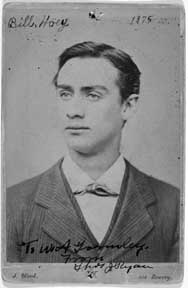William F. Hoey
Born: 1854 in New York, NY
Died: 1897 in New York, NY?
Father: Thomas Hoey
Mother: Bridget Coffey
Submitted by: Arthur Hoey
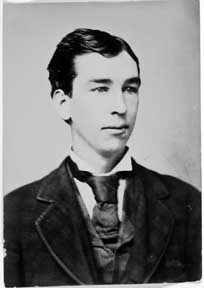
About 1857: Brother James F. Hoey born.
1860 Federal Census-10th district, 17th ward, New York, NY:
Thomas Hoey, head, 36, shoemaker, born Ireland
Mary Hoey, wife, 30, born Ireland
William Hoey, son, 3, born NY
James Hoey,
son, 2, born NY
1870 Federal Census- New York, NY:
Bridget Hoey, mother, 37, keeping house, born Ireland
William Hoey, son, 14, clerk in store, born NY
James Hoey,
son, 12, born NY
Mary Ann, daughter, 9, born NY
Delia Hoey, daughter, 8, born NY
Kate Hoey, daughter, 5, born NY
Margaret Hoey, daughter, 4, born NY
Alice Hoey, daughter, 2, born NY
1873: First appearance as a black-face comedian/concertinist on the minstrel stage; see Edward LeRoy Rice, Monarchs of Minstrelsy, From “Daddy Rice” to Date (New York: Kenny Publishing, 1911), 182, 264.
Early 1870s: Performed at Tony Pastor's Theatre as a musical black faced actor with solos on cowhorn and cowbells.
1875: Performed in Col. Carrington's Circus.
1875-1878: On stage as Fields and Hoey (John F. Fields and William F. Hoey) in a minstrel show. It appears that William Hoey was an accomplished concertinist.
The origin of the nickname or stage name of "Old Hoss" is unknown. It may have been the character in the play A Parlor Match.
1880 Federal Census-428 12th Street, New York, NY:
Mary Coffey, mother, 70, wash woman, born Ireland
Bridget Hoey, mother, 45, housekeeper, born Ireland
William Hoey, son, 24, variety actor, born NYC
James Hoey,
son, 22, variety actor, born NYC
Delia Hoey, daughter, 18, paper boxes, born NYC
Kate Hoey, daughter, 15, at home, born NYC
Maggie Hoey, daughter, 14, at home, born NYC
Alice Hoey, daughter, 11, at home, born NYC
22 September 1884: First appeared as Evans and Hoey in A Parlor Match written by Charles Hoyt at the Tony Pastor's Theater.
Dancers Helen and Minnie French appeared at New York's Standard Theatre with D'Oyly Carte's First Billee Taylor Company from February to May 1881. Billed as "The French Twin Sisters," the sisters danced the "Sailor's Hornpipe and special dance" according to the program. It was their only engagement with the D'Oyly Carte organization. The twins had earlier appeared on Broadway in a Tony Pastor burlesque of H.M.S. Pinafore called T.P.S. Canal Boat Pinafore (February-April 1879). "The French Twin Sisters" first appeared on the vaudeville stage at age fourteen and were for years a very successful song and dance team. Helen French married William F. "Old Hoss" Hoey of the vaudeville team of Evans & Hoey. The twins had been engaged by Evans & Hoey to appear in A Parlour Match in 1885, and ended up marrying the team.
1882: Partner Charles Evans marries Minnie French.
About 1883: William Hoey marries Helena G. French (b 1863) perhaps in New York.
22 March 1888: Evans and Hoey in "Parlor Match" at LaCrosse, Wisconsin.
1888 theatre ad for Evans & Hoey at Havlin's Theater in Cincinnati, in their latest laughing success, A PARLOR MATCH by Charles Hoyt. The supporting cast was: J. T. Galloway, M. J. Sullivan, E. C. Jobson, Hugh Mack, Peter Randall, William Keogh, Thomas Dunbar, Ollie Archmere, Agnes Lawrence, Halla Archmore, Mabelle Stuart, Emily Willett and Minnie French. Synopsis: Act I- At Captain Kidd's. Digging for the Treasure; Act II - McCorker's Headquarters. Still Digging.; Act III - Parlor in Captian Kidd's House. Finding the Treasure. The comedy was interspersed with 11 Musical Selections.
1889-1890 New York City Directory: Hoey, William actor h 239 W 127th.
12 March 1890: Evans and Hoey in "Parlor Match" at LaCrosse, Wisconsin.
2 April 1891: Evans and Hoey in "Parlor Match" at LaCrosse, Wisconsin.
1894: Poster advertising "Old Hoss" Bill Hoey in "The Flams." Hoey played Marmaduke Flam.
"The Illustrated American", Vol XVI, No. 245, For the Week Ending 27 October
1894, p. 538
OUR GALLERY OF PLAYERS* CLXVI WILLIAM E. HOEY
I presume that it will strike some--many--persons as an absurdity to speak of
William E. Hoey--"Bill" Hoey is the way he is usually spoken of--as an artist.
He is an artist, though. His style of performance may be coarse and rough; but his manner
of doing it is refined and his methods genuinely artistic in their way. The plays in which
he disports--"Flams", "The Parlor Match" and so on--are not such as
the world of letters unwillingly lets die; but for all that there is a distinctive
delicacy in Hoey's extravagances, a nice sense of proportion, coloring, high light and
shadow that give his effects the character of intelligently conceived impresonations. An
therefore I make bold to term Mr. Hoey an artist.
I wonder that Hoey--and men like him--never put their obvious gifts to more
pretentious, ambitious uses. That they never attempt Falstaff, for example. O, don't look
so shocked dear reader. When Shakespeare ran the Globe Theatre you may be sure Falstaff
was played by many an actor less adapted for the role than Hoey. For my part I should like
to see Falstaff acted by such a player as he. However, I hope Mr. Hoey won't be carried
away by my suggestion and immediately make a hazard of the role.
*This series of prominent actors and actresses was commenced in No. 71 of The Illustrated
American.
1895-1896: Performed in "Globe Trotters" with Beatrice Moreland.
September 1895: Performed as Buttsy in "Globe Trotters" at the Hollis Street Theatre in Boston.
21 September 1896: Ziegfeld's musicalized version of A Parlor Match opened at the Herald Square Theater.
September 1896: A Parlor Match - This was a musicalized version of the popular Evans and Hoey comedy about a tramp who steals from a wealthy family starred its authors. This production is best remembered as Anna Held's Broadway debut. She made a special appearance in the second act as a "ghost" who emerged to sing a few songs before leaving so the show could resume. It ran for six weeks before a five city tour. It was Florenz Ziegfield's first Broadway production.
Florenz Ziegfeld persuaded the leading comedy team of Charles Evans and Bill Hoey to
star in a musicalized version of their popular comedy A Parlor Match. (It was the story of
a hobo who pilfers valuables from an unsuspecting millionaire.) The authors would repeat
their original roles in the show, and Ziegfeld and Evans sailed to Europe in search of a
new female star to spice up the second act. In London, they saw music hall sensation Anna
Held. Her colorful French accent, eighteen inch waist, hourglass figure and coquettish
personality captivated both men – especially Ziegfeld. Aware that she was under
contract to the Folies Bergere, he wined and dined her with relentless zeal. It is
doubtful that his sole motivation was love – unless one means love of money.
For all her aristocratic Parisian ways, Held was the Polish-born daughter of a Jewish
glove maker. She made her stage debut in England and rose to fame in the cafes of Paris.
Although married, her husband's heavy gambling had long since driven them apart, so Held
proved quite susceptible to Ziegfeld's advances. She soon gave him her heart, as well as
her signature on a contract. When the Folies Bergere demanded a $1,500 pay off for the
loss of Held's services, Ziegfeld (who had spent the last of his bankroll wooing Anna) had
close friend "Diamond" Jim Brady wire payment from New York. By the time Held
crossed the Atlantic, Ziegfeld's relentless publicity efforts had her name and photo in
every major newspaper. All Anna had to do was be sensational.
The 1896 Broadway revival of A Parlor Match had two musical highlights – the hit song
"Daisy Bell" (also known as "A Bicycle Built for Two"), and Anna
Held's performance of the playful "Won't You Come and Play With Me?" To
guarantee ongoing publicity, Ziegfeld let out word that Held took daily milk baths, and he
won headlines by suing a popular dairy for sending sour milk. The outraged dairy owner
soon revealed that it was all a hoax – Held bathed in scented water that just looked
milky. The brouhaha succeeded in making Held a national celebrity. After a calculated
brief run (guaranteeing too few tickets for the growing demand), Ziegfeld took A Parlor
Match on tour for several months. Held's continental style and lavish tastes added to her
appeal, drawing curious audiences everywhere she performed.
29 June 1897: Died in New York at his home. Buried at Woodlawn Cemetery (Hemlock) in the Bronx, NY
WILLIAM HOEY (1955-1897)
Actor, Comedian
Known as "Old Hoss", Hoey was a successful Vaudevillian. He partnered with
Charles Evans and they first appeared in A Parlor Match. His inventions of traps and other
mechanisms allowed him to be "thrown around the stage," ; Woodlawn Cemetery
(Hemlock), Bronx, NY
New York Times Obituary 30 June 1897:
DEATH OF "OLD HOSS" HOEY
Paresis End the Career of the Well-Known Actor in Farce Comedy
ON THE STAGE FROM BOYHOOD
His Experience in Tramping from Savannah Back to This Native City Suggested the Funny
Pranks that Brought Him Success
William F. Hoey, known to every theatregoer in the United States as "Old Hoss"
Hoey, died yesterday morning at his home, 201 West One Hundred and Twenty-third Street of
paresis. His final illness was as brief as it was violent, having developed only last week
at Mount Clemens, Mlch. where he was seeking relief from an attack of sciatIc rheumatism.
He was brought to this city last Friday, and while his condition was considered serous it
was not thought that death was so near.
Mr. Hoey had been before the public for over twenty years. He was born in this city in
1854 and began as an actor when only fifteen years of age. He appeared as a comedian in
the early seventies at Tony Pastors old theatre on the Bowery, taking the part of a
Musical Coon. His antics were inexpressibly funny, and his solos on a cowhorn and cowbells
became a feature of the performance.
Early in his career he sprang into popular favor, and was much sought after by the
vaudeville managers. His natural resources and his humorous pranks gave him a hold on the
patrons of variety theatres that carried him all through life.
In 1875, Hoey engaged with Col. Carrington’s circus, and the following year he
accepted an engagement from a manager in Savannah, Ga. He played there for three weeks,
but received no salary and finally started to walk from Savannah to his home In New York.
It was while making this trip that his keen sense of humor enabled him to appreciate the
comical side of the existence of a tramp. He conceived the character of “Old
Hoss” and determined to utilize the character of the tramp in his future efforts on
the stage.
On reaching New York Hoey formed a partnership with Frank Bryant, but soon rejoined Tony
Pastor's Company, with which he remained until 1882. He then combined with Charles Evans
and the French sisters in the presentation of a sketch entitled “The Book
Agent.” This farce was successful from the start, and was presented for a number of
years. Finally Charles Hoyt converted it into a more elaborate piece and " A Parlor
Match” came into existence almost simultaneously with the appearance of the real
parlor match that superseded what Hoey called the telephone match. “You light it in
New York and smell it in Brooklyn," was his definition of the sulferous article.
Until two years ago “A Parlor Match” was always a drawing card, due in a great
measure to the inexhaustible supply of humor possessed by Mr. Hoey. In addition to his
ability to act ludicrously, he could devise the queerest “make-ups" ever worn by
a comedian. He was also somewhat of a mechanical genius. All the traps and contrivances
which would throw him around the stage and make him appear and disappear with
lightninglike rapidity, always with a different expression of bewilderment on his face,
were his own inventions.
Two years ago he and Evans, after a partnership of ten years, separated. Evans retired
from the stage and invested money in the Herald Square Theatre, while Hoey started out
again in a new farce called “Flams" and subsequently “The
Globetrotter.” Neither of these was a success, and last Fall a revival of “A
Parlor Match” was produced. But though he was only in his forty-third year Mr. Hoey's
health was shattered, and thestrain of a tour of the country proved too much for him. He
broke down and was compelled to retire.
The funeral will be held this evening at 8 o'clock at his late residence, the Rev. Dr.
Elmendorf of the First Congregational Church officiatlng. The interment will be at
Woodlawn tomorrow.
Note: 23 June 1914 NYT Article-The Herald Square Theatre at 35th and Broadway was owned by Evans and Hoey in 1897.
New York Times: Jun 24,1899
SUIT OVER HOEY’S PROPERTY
Winesses Say Comedian Was Sane at Time of His Death
The suit over the property of William Hoey, the comedian, which was brought by Mrs.
Bridget Hoey, his mother, against Mrs. Helena G. Hoey, the actor's widow, to set aside
conveyances of two dwelling houses which he made over to her nine months before his death,
was continued yesterday in the Supreme Court before Justice Russell. The mother of the
dead actor claims that Mrs. Hannah French, his mother-in-law and his wife exercised undue
influence over him, he being at the time he executed the transfers of the property in an
unsound mental condition. Hoey's widow denies the allegation.
John M. Cooke, who had been Mr. Hoey's manager, testified to the execution of the deeds
conveying the property from Hoey to his wife. He said when arranging for the execution of
the deeds that he wanted to leave everything to his wife and to provide a home for her
when he was gone.
John S. Cushman said he had seen Hoey two weeks before his death. He then was very weak
but otherwise appeared to be in full possession of his senses. Miss Beatrice Moreland,
leading woman with Mr. Hoey in the " Globe Trotters " during the season of
1895-6 said the comedian always spoke his lines correctly and never appeared to be
affected in his mind.
Dr. James A. J. O'Brien, who said he had been a Surgeon Major in the British Army,
testified that he had attended Mr. Hoey as his family physician and that he never was
insane. He attended him in July, 1896, and found him suffering from pleurisy. He again
attended him in June, 1897, a week before he died, when he was affected by sciatica.
Charles E. Evans, the partner of Hoey said the dead actor was never insane and was in
possession of his full senses when he executed the deeds to his wife. The witness was
asked if he did not think it a strange thing for a man to go about a village street
dressed up as a woman and blowing a bagpipe. He answered that it might be strange for some
people, but not for Hoey.
Justice Russell, after hearing all the evidence, reserved decision.
1900 Federal Census: 156 East 84th Street,
New York, NY
Bridget Hoey, head, Dec 1835, 64, widow, 7 children, 5 surviving, immigrated 1865, born
Ireland. Note: William's mother
Kate Hoey, daughter, Oct 1870, 29, saleslady, born NY
Margaret Hoey, daughter, May 1874, 26, saleslady, born NY
May Hoey, granddaughter, Sept 1881, 18, at home, born NY. Note: Are these
William's children?
William Hoey, grandson, March 1883, 17, Brokers Office, born NY
Jennette Hoey, granddaughter, April 1885, 15, at home, born NY
18 October 1901: William's wife Helena G. French dies of Brights (kidney) disease at the home of her mother, Mrs. H. M. French, at 207 West One Hundred and Twenty-third Street in New York. It is not known where she is buried.
1924: His brother, James F. Hoey, dies in Sayville, NY. James had also been a vaudeville comedian.
|
Bill Hoey 1875 |
|
Fields and Hoey 1875 |
|
America's
Own Musical Artists |
John F. Fields and William F. Hoey c 1875 |
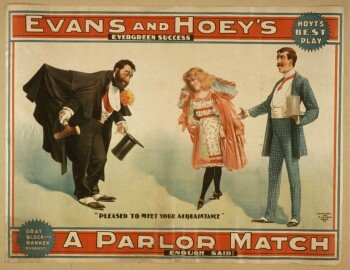 |
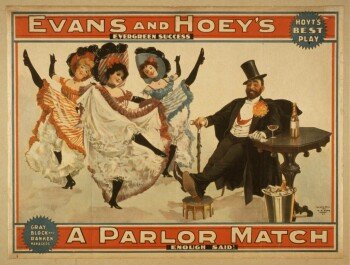 |
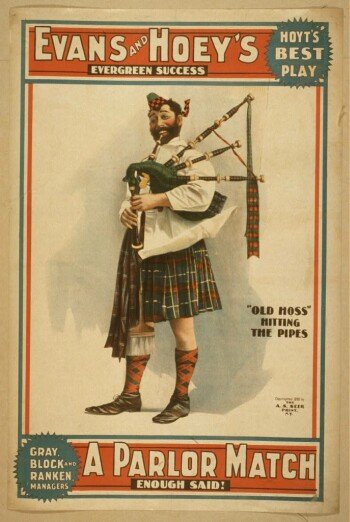 |
